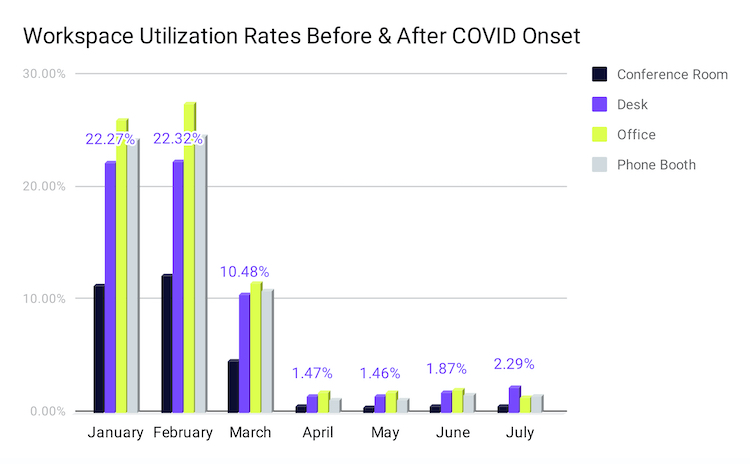Fortune 500 Companies Are Turning to Agile Seating
.png)
VergeSense is the industry leader in providing enterprises with a true understanding of their occupancy and how their offices are actually being used.
COVID-19 has thrust the CRE industry into another transformative era. Causing C-suites to reflect on how they’ve supported employee productivity in the past and employees to redefine what the workplace means to them, the pandemic has sparked a momentous shift in how people work and stay safe simultaneously.
At the onset of the crisis, this meant a mass migration to remote work. But six months on, and as the fatigue of working from home full-time begins to set in, workplace leaders are laboring to implement return-to-work strategies that meet their employees’ new expectations for flexibility and safety.
To examine how office utilization has changed since the COVID-19 infiltrated news headlines, VergeSense analyzed data from 20M SQFT of office space — specifically focusing on how utilization rates for desks, private offices, conference rooms, and phone booths have shifted.
Here’s what we found.
Hot Desks Are Heating Up
Although we found that overall office utilization has struggled to rebound, early signs are pointing to an increased usage of agile work settings — like hot desks — that offer companies the flexibility they need when headcount changes daily. The utilization of these types of workspaces is gradually increasing as more employees return to the office. Other workspaces, however, remain stagnant with minimal utilization.

The utilization of private offices, for example, dropped from 28% in February to just over 1.4% in July. And conference rooms, which were poorly utilized even before the pandemic, experienced yet another stark decrease in utilization from 12% in February to 0.6% in the summer months. Meanwhile, phone booth utilization, which peaked at 25% in February, fell to 1.5% in July.
What these data tell us is consistent with what we’ve been hearing from our customers. That is that as companies recover from COVID-19, they’re shifting to more flexible seating plans that make office re-entry easier and safer, and also optimize the value of CRE in the new normal that follows.
From a safety standpoint, shifting to flexible seating in the near-term means workplace leaders can realize efficiency while catering to non-essential employees evolving needs as they choose to return to the workplace. This is because it’s a more on-demand approach where employees can book workspace only when needed. Desk reservation systems enable easy reserving a desk online in advance and occupancy sensors make real-time availability visible. This also enables companies to optimize cleaning and sanitization once employees are finished using a space.
And longer-term, many organizations are beginning to see the writing on the wall. Even pre-pandemic, for instance, workplace utilization hovered around 30%. Post-pandemic, with many employees likely only going to be office-based 2-3 days per week, we can expect utilization to drop even further. As a result, companies are looking at consolidating footprints and designing workspace to be less dedicated and more collaborative, and again, deploying technology that allows employees to book workspaces online and CRE leaders to optimize a truly on-demand workplace.
Flexibility is the New Normal
As companies reopen their offices, flexible seating discussions have been heating up and companies clearly see the economic benefit of more agile workplaces.
After all, why should employers pay for dedicated desks for every single employee when employees are spending half the week working from home? The new normal is an office that is not just a warehouse of assigned desks, but a haven where employees choose to experience socialization and collaboration with their colleagues. And our data hints at what many are calling the rebirth of the office where CRE leaders drop drab work designs for agile environments that optimize both the employee’s experience and the value of their portfolio.
The nature of the office continues to evolve!